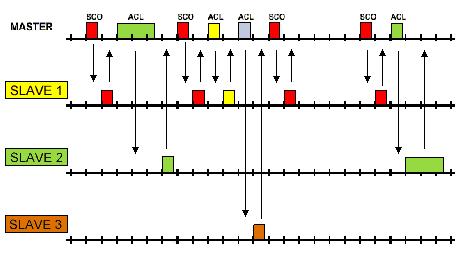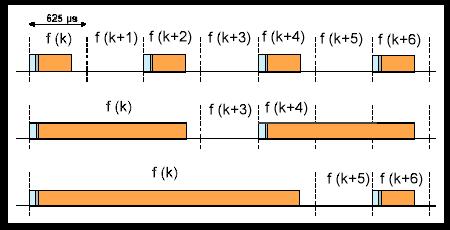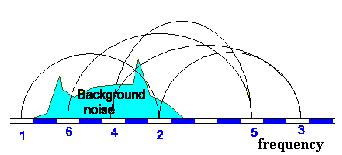
In the early 1990's, Ericsson Mobile Communications sought to do away
with the seemingly endless mass of cables that was needed to connect a
computer to its peripherals. In 1994, Ericsson began work on a
wireless technology called Bluetooth. Since then many companies
have adopted Bluetooth technology, making it the standard for a small,
low power, cheap radio chip to wirelessly link computers to printers,
PDAs, keyboards, etc.
Bluetooth, however, is not limited to use by a single PC and its
peripheral devices. Bluetooth is also designed to support the
creation of ad hoc networks between any Bluetooth enabled devices.
For example, it would be possible to connect a mobile phone to a nearby
printer, printers to other printers, or your television to a hi-fi
receiver. A chip could be placed inside a cargo container and used to
track a variety of information. The uses for Bluetooth are as
limitless as the designers' creativity.
Bluetooth provides robust communication over relatively short
distances (about 10 meters) between devices which require sporadic
contact with one another. It is not intended to replace high traffic
networks such as LANs, WANs, and backbone cables.
The Bluetooth radio operates in the globally available ISM band of
2.4 GHz. This ensures that Bluetooth enabled devices will be able to
communicate anywhere in the world. To avoid interference in this noisy
radio frequency environment, Bluetooth uses fast frequency hopping in
timeslots. By frequently hopping to a new frequency, the link can
avoid spending too much time in particularly noisy range.
It also uses short packets, which, together with the
frequency hopping, reduces the effects of electro-magnetic disturbances
, such as microwave ovens or cordless phones. Other coding techniques
are used to minimize the impact of random noise in the channel.
Bluetooth was specifically designed to support ad hoc networks.
That is, different devices can be connected for varying amounts of
time. At the simplest level, the architecture of a Bluetooth network
is called a piconet, which is defined by
www.webopedia.com as:
A network of devices connected in an ad hoc fashion using
Bluetooth technology. A piconet is formed when at least 2 devices,
such as a portable PC and a cellular phone, connect. A piconet can
support up to 8 devices. When a piconet is formed, one device acts as
master, and the others act as slaves for the duration of the piconet
connection. A piconet is sometimes called a PAN (personal area
network).
In a piconet all communication is between master and slaves. Slave
units can not talk to each other. Nor is the master responsible for
routing information between slaves within a piconet. If two slaves
wish to communicate, they must form a new piconet. A device may be a
slave in several piconets, but may only be master of one. This
interconnection of piconets is called a scatternet.
Devices which belong to more than one piconet will spend certain
timeslots on each network. A device may choose to be "parked" or on
"hold" in its original network, or it may choose to leave it
altogether. Either way, Bluetooth is designed to support exactly this
type of dynamic reconfiguration.
Bluetooth uses frequency hopping in the 2.4 GHz ISM band. There
are 79 hop frequencies spaced 1 MHz apart from 2.402 GHz to 2.480 GHz.
The hopping sequence is determined by an algorithm involving the
master's device address. All devices in a piconet will follow this
same sequence.
Establishing a piconet is done through a series of paging and
scanning procedures. A device can determine what Bluetooth devices are
within range and request a connection if it so chooses. The device
initiating the connection becomes the master and the other the slave by
default, although a master/slave switch be done if the slave is not
already a master of another piconet.
The master takes turns communicating with each slave in a periodic
fashion. Time is divided into 625 us slots. The master transmits at
the beginning of even-numbered slots, while slaves may transmit only
at the beginning of odd-numbered slots. Thus, it is important that all
units be closely synchronized to the master's clock.
The master can maintain both synchronous (SCO) and asynchronous
(ACL) connections with its slaves. In an SCO connection, the channel
is reserved for two time slots for communication between the master and
a particular slave. The period of these reserved slots is set by the
master, and may be a function of priority. This is similar to circuit
switching. Each slave gets a turn. The time slots are allocated
whether or not either master slave has anything to transmit at that
time. ACL transmissions may occur in between the time slots reserved
for SCO links. In the illustration below, notice that the SCO link
between master and slave 1 occurs every six time slots. In between
these slots the master may transmit ACL packets to any slave.

Each time slot is associated with a frequency in the hopping
sequence. Therefore, if a transmission lasts 3 time slots, the next
frequency will be the third one in sequence from that of the last
transmission. That is, frequencies will be skipped if a packet takes
more than 625 us to transmit, or if no one has anything to transmit at
all. The illustration below shows three possible scenarios.

When Ericsson first introduced its Bluetooth technology in 1998, it
was touted to revolutionize the way consumers use and interact with
mobile computing and communications devices. There was a tremendous
amount of hype. Several companies, including Ericsson, Intel, Motorola,
and IBM, joined the Bluetooth Special Interest Group (SIG) to monitor
and promote Bluetooth development. Unfortunately one of BLuetooth's
biggest selling points, its low cost, was never realized. Until very
recently a Bluetooth chip would have cost device manufacturers around
$10. This was too high a price for the cost sensitive mobile
electronics industry. Bluetooth took a huge step backwards in early
2001 when Microsoft said that its then new Windows XP would not support
Bluetooth.
A break for Bluetooth came in June of 2002 when Texas Instruments
announced that it would be releasing a new Bluetooth chip early next
year for under $4. These declining component costs and a booming
interest in all things wireless has led to a resurrection of Bluetooth
technology. What was once a technology on the demise, is now the
foundation for the newest wave of personal mobile computing and
communications capabilities.
According to the Business2.0 article entitled
"Bluetooth to Break Through Gum Line", research from IDC indicates
that revenues from Bluetooth related products, such as chips and memory,
will grow from $76.6 million in 2001 to $2.6 billion in 2006, with
widespread adoption beginning next year. Cell phone handsets are
expected to account for nearly 51% of these revenues, with headsets
for handsets accounting for the next largest piece of the pie. With
statements like the one below from the PalmOS website, it is not hard
to believe such predictions.
As an associate member of the Bluetooth Special Interest
Group, Palm is committed to helping Bluetooth become the standard for
a new style of computing that will extend the way people use their
handheld computers.
The IEEE 802.11 standard specifies two types of networks: ad hoc,
and client/server. Bluetooth is based on the standard for ad hoc
networks. The main difference betweeen Bluetooth and Wireless LANs
based on the IEEE 802.11 is that Bluetooth is intended for transmitting
small amounts of data (about 1 Mbps) over short distances (10 meters),
while WLANs can support higher datarates (2 to 11 Mbps) over much
larger distances (up to 100 meters). Perhaps the most defining
distinction between the two is that Bluetooth is specifically
designed to support rapid and dynamic reconfiguration. This is not
how LANs work. In addition, Bluetooth is cheaper to insert into
devices and consumes less power, which makes it ideal for the usage
model of the personal area network. Thus it appears as though
Bluetooth and 802.11 will ultimately coexist.




